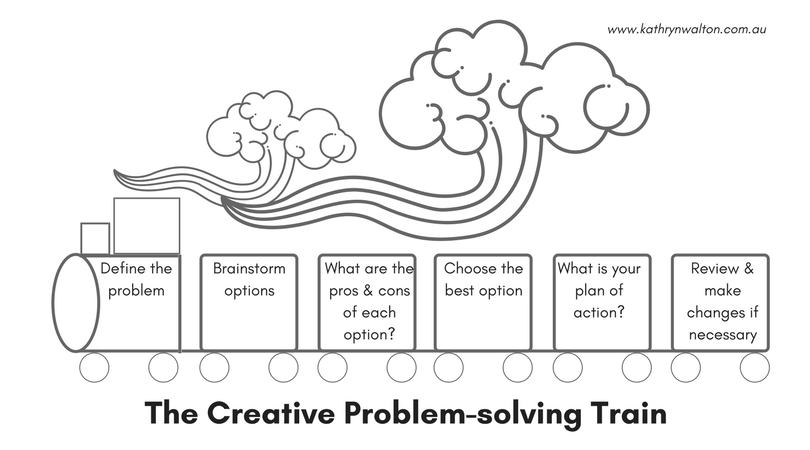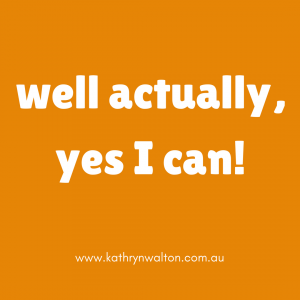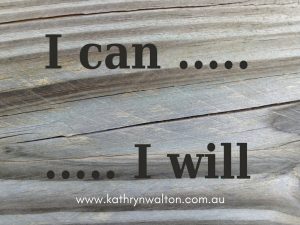
Today it’s all about smashing your goals in 6 simple steps using what I call “The Creative Problem-solving Train” model. My last blog post outlined the steps you need to take to successfully plan your goals, no matter how big or small. And today’s blog will help you to overcome the obstacles that can get in the way.
Human brains have evolved to focus more attention and energy on the problems of life than the things that are going well. So it’s no surprise that when we start to detail the specifics of our goals, our brains start thinking about all the things that will get in the way of success. Our inner chatter gets louder and louder. It itemises the multitude of reasons why we’ll never achieve our goal. And it all too often convinces us that it’s a waste of time even trying.
 The key to managing this is to NOTICE that it’s happening. If you are are not aware of your inner chatter, you will unconsciously believe it and go along with it instead of challenging it.
The key to managing this is to NOTICE that it’s happening. If you are are not aware of your inner chatter, you will unconsciously believe it and go along with it instead of challenging it.
Use your powers of observation to notice what’s going on inside your head, and then consciously choose how to respond to your inner chatter. This is your window of opportunity for getting on board “The Creative Problem-solving Train” that will deliver you to your destination – your goal!
So, let me introduce you to …
The Creative Problem-solving Train! Each carriage has a task to perform but remember to always drive the train from the driver’s carriage! This is where you get really clear about what the problem actually is so that you stay on track from the very beginning! The Creative Problem-solving Train is explained below in 6 simple steps so that you’ll smash your goals despite any obstacles, problems, barriers, issues or hurdles that arise.

 The Carriages (or steps, if you prefer!)
The Carriages (or steps, if you prefer!)
1. Always start from the driver’s seat no matter how tempting it is to jump straight into one of the other carriages!! List all the ‘possible’, ‘probable’ and ‘unlikely’ problems, barriers and obstacles that might get in between you and your goal. Be honest and open with yourself and about your situation. It might seem counter-intuitive but don’t hold back. Bringing the issues out into the light of day and writing them down will DISEMPOWER THEM, and EMPOWER YOU towards your goal. If you notice an urge to deny or avoid the issues, write that down too. Shame, perceived laziness and fear are all barriers that can rob us of the opportunity as well as the joy of achieving goals.
2. Choose ONE of your ‘probable’ obstacles and brainstorm solutions to it. You’re not  analysing your ideas at this stage so let go of the urge to find reasons why they won’t work. Remember to keep the CREATIVE in your creative problem-solving. Let the ideas flow no matter how crazy, impossible, or ridiculous they might seem. It’s often the ‘way out’ ideas that create a pathway to a solution, so get them all out there. Write them all down!
analysing your ideas at this stage so let go of the urge to find reasons why they won’t work. Remember to keep the CREATIVE in your creative problem-solving. Let the ideas flow no matter how crazy, impossible, or ridiculous they might seem. It’s often the ‘way out’ ideas that create a pathway to a solution, so get them all out there. Write them all down!
3. Now it’s time to do a quick analysis of the ideas you’ve thought of. Write down the pros and cons of each option.
4. Select the option that seems to be the best one, but don’t be overly focused on making the ‘right’ choice. Simply go with the one that seems the best in this moment.
 5. Write down your Plan of Action so that you have a clear and concise guide to implementing your selected option.
5. Write down your Plan of Action so that you have a clear and concise guide to implementing your selected option.
6. Review the process. Has your selected option helped to solve the problem? Does it need  more time? More resources? Do you need to modify it? It’s important at this point to persist with your problem-solving rather than giving up with your goal. Persistence is a valuable skill that everyone can learn. It can make the difference between throwing your goal away, and celebrating success. If it’s clear that your selected option is not going to work, you can discard it and select a different one. Go back to Step Number 4 to choose a different idea and work your way through again. You might need to repeat these steps multiple times to find the best way forward. Combining two or more solutions might even be the most effective approach.
more time? More resources? Do you need to modify it? It’s important at this point to persist with your problem-solving rather than giving up with your goal. Persistence is a valuable skill that everyone can learn. It can make the difference between throwing your goal away, and celebrating success. If it’s clear that your selected option is not going to work, you can discard it and select a different one. Go back to Step Number 4 to choose a different idea and work your way through again. You might need to repeat these steps multiple times to find the best way forward. Combining two or more solutions might even be the most effective approach.
You can use the Creative Problem-solving Train process to work your way through all or any of the problems you’ve identified. Before you know it you’ll have a well-rounded strategy to manage everything that stands between you and your goal. If any new obstacles surface, use the same process to deal with them.
 Blending creativity and logic is a powerful way to achieve success. Don’t allow your inner chatter stop you from getting started with your goals. And don’t let the obstacles limit you or your achievements. Follow the Creative Problem-solving Train to develop persistence and propel you forwards. Your mental health will thank you with improved self-confidence, resilience and unstoppability.
Blending creativity and logic is a powerful way to achieve success. Don’t allow your inner chatter stop you from getting started with your goals. And don’t let the obstacles limit you or your achievements. Follow the Creative Problem-solving Train to develop persistence and propel you forwards. Your mental health will thank you with improved self-confidence, resilience and unstoppability.
Next week I’ll share a goal with you that I’m working on for myself. Something I’ve been considering taking on for some time but haven’t because I’ve been playing it safe! But in my heart I know that I’m holding back on myself and will be disappointed if I don’t at least give it a try. I’ll lay all the obstacles out on the table (and there are plenty of them!) and I’ll use the Creative Problem-solving Train to help me develop a strategy to deal with them so that I’ll experience that sweet taste of success that comes with achieving a goal.
Discovering mountain biking as life’s ultimate parallel universe in her middle age,  Kathryn Walton shares information and reflections in Daisy Spoke that connect, inspire and self-empower women to make healthy choices for themselves. She integrates her love of physical exercise, family, nature, gardening and creative arts with her professional background in mental health social work to facilitate change with individuals, groups and communities of women who are committed to living life to the full.
Kathryn Walton shares information and reflections in Daisy Spoke that connect, inspire and self-empower women to make healthy choices for themselves. She integrates her love of physical exercise, family, nature, gardening and creative arts with her professional background in mental health social work to facilitate change with individuals, groups and communities of women who are committed to living life to the full.
 time I respect them. I teach many individuals and groups how to use goals to enhance their mental health and wellness, and I see amazing progress when they are used effectively.
time I respect them. I teach many individuals and groups how to use goals to enhance their mental health and wellness, and I see amazing progress when they are used effectively. 
 Remember all those problems your mind started to thinking about in Step 2? Problem-solving is where the power is (another blog later this month will look at this in more detail). Persistence makes all the difference between giving up on your goal (and yourself) and being unstoppable. Some of the problems will be predictable and you’ll be able to plan for them. Others less so.
Remember all those problems your mind started to thinking about in Step 2? Problem-solving is where the power is (another blog later this month will look at this in more detail). Persistence makes all the difference between giving up on your goal (and yourself) and being unstoppable. Some of the problems will be predictable and you’ll be able to plan for them. Others less so. In the meantime, if you haven’t already signed up for Grounded Inspiration, now’s a great time to do that. Never miss out on the latest news, inspiration or blog posts! And be the first to hear about my new releases throughout the year as I develop and publish programs to enhance women’s wellness and professional knowledge.
In the meantime, if you haven’t already signed up for Grounded Inspiration, now’s a great time to do that. Never miss out on the latest news, inspiration or blog posts! And be the first to hear about my new releases throughout the year as I develop and publish programs to enhance women’s wellness and professional knowledge.